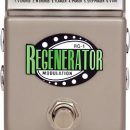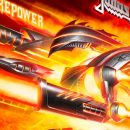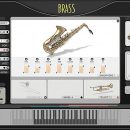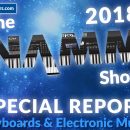Dave Smith is a tireless synthesizer designer. He just refuses to slow down, whipping up killer new synthesizers faster than you can reload your bank account. And the DSI product family keeps expanding, because like other fine instruments, each new synthesizer is just different enough from the last to justify its own place in the product lineup.
| Category | Value | Rating |
| Features | 20% | |
| Usability | 25% | |
| Sound | 25% | |
| Documentation & Support | 10% | |
| Price | 20% | |
| OVERALL RATING = 3.5 3.6 stars or better: Outstanding, WIHO Award 3 stars or better: Worth considering 2 stars or better: Suited to specific needs 1 star or less: Not recommended |
||
We’ve had a love affair with virtually every product to leave Dave’s San Francisco shop. Even if each synthesizer doesn’t contain every granular detail that, say, a modular synth gearhead might desire, we love the gear because every one of Dave’s instruments is focused on musicality and usability, and we’re musicians first and foremost. DSI synths are synths for players who make music and create sounds, not just boxes for guys who like to twist knobs and tinker for the sake of making new swishing, blurping, percolating, pulsing tones (though you can certainly create many of those sounds).
In the case of the Prophet-8 and Prophet-12, we loved how those keyboards gave us some classic Prophet mojo in slightly different shades. But neither those nor the Pro-2 (or other DSI models we’ve played over the years) really prepared us for Dave’s latest masterpiece: the Sequential Prophet-6.
Unlike Dave’s other innovative synths, the Prophet-6 first takes a step back into the past, and then goes back… to the future! This pure analog polysynth is a modern classic that accomplishes something we’ve never seen before: it renders the legendary, classic Prophet-5 unnecessary, so much so that we can’t imagine anyone would ever feel the need to purchase one of those ever again other than for pure nostalgia sake.
In a nutshell, the Prophet-6 presents an update to the classic Prophet-5 that retains virtually everything spectacular about the classic synth’s sound and straightforward user interface; then adds a host of updated features that make the keyboard far more versatile than the original. While other models in the Prophet series deliver sounds “in the family,” and the Prophet-8 gets particularly close to the classic at times, the Prophet-6 truly delivers genuine Prophet-5 tone at a minimum, and then goes above and beyond. For any player who ever lusted for a Prophet-5 (half of our editors raised their hands, I think), without question this is the synthesizer to get.
Features
As with the DSI Prophet ‘08, the new Sequential Prophet-6 is analog from end to end (not counting some of the effects, but more on that later). In the few places where there is some digital stuff happening inside, it’s only for the greater good, and never at the expense of analog tone.
The first key differentiator with the Prophet-6 is that it is built around a pair of analog, voltage-controlled oscillators, whereas everything else in the DSI lineup has either digital oscillators or analog DCOs.
At a glance, the Sequential Prophet-6 looks a heck of a lot like the classic Prophet-5, presenting a very similar signal path, and a very similar user interface—right down to the familiar grey, plastic buttons for patch selection. The most obvious difference, however, is a matter of keys: the new machine sports just 49 keys compared with the classic’s 61-key keyboard. Yes, that is a divisive issue for many, but on the flip side of that, the modern synth has velocity and polyphonic aftertouch, whereas the original had neither.
 There are a number of… ahem… key differences that make the Prophet-6 the superior instrument:
There are a number of… ahem… key differences that make the Prophet-6 the superior instrument:
- Six voices, as opposed to the Prophet-5’s lower voice count (that would be five, in case you haven’t figured out Dave’s naming conventions by now).
- The Prophet-5 had two oscillators per voice, but the Prophet-6 also adds a sub oscillator. And while the Prophet-5 had fixed triangle, sawtooth, and pulse waveforms, the Prophet-6 has continuously variable waveforms, allowing for much greater variety of sound right from the start.
- The Prophet-5 sported a basic low-pass filter, but the Prophet-6 ups the ante with both a four-pole, resonant, low-pass filter, as well as a two-pole, high-pass filter.
- The original Prophet-5 pre-dates Dave Smith’s co-invention of MIDI (though a retrofit was available for late-model P-5s), so the old keyboard is basically an island unto itself. Besides full MIDI capabilities, the Prophet-6 also adds an arpeggiator and step sequencer. These are sync-able via MIDI, though they only sync to incoming MIDI clock signals—they don’t act as the master.
There are other enhancements that aren’t as headlining grabbing, most notably… tuning stability! Young keyboard players don’t know what is involved in maintaining old, analog synths with voltage-controlled oscillators. They were notorious for drifting out of tune, and keeping them in tune required opening the synths up (the Prophet-5 had a flip-top lid for easy access) and connecting an oscilloscope while making adjustments with a screwdriver. We were reminded of this while watching the recently released, Genesis, 3 Sides Live, Blu-ray, where the behind-the-scenes documentary footage showed Tony Banks performing his routine, pre-show, Prophet-5 tune-up.
Dave Smith developed a new, modern VCO for the Prophet-6 that has the tuning stability we’ve all come to expect from modern synthesizers, and in fact, the Prophet-6 adds a Slop control that enables you to dial in a desired amount of tuning differential in case you really want to emulate the funky tuning of yesteryear.
Poly Mod was a beloved feature in the classic polysynth, useful in creating sweeping/evolving sounds, and and it has been enhanced to suite the expanded sonic capabilities on tap in the Prophet-6. Poly Mod enables you to select a filter envelop and/or the second oscillator’s frequency and use them to modulate destinations including oscillator 1’s frequency, shape and pulse width, low-pass filter cutoff frequency, and high-pass filter cutoff frequency. Modulation amount can be positive or negative. Overall, these capabilities are more expansive than the P5’s positive-only poly mod section, which also had fewer destination routings.
For lead sounds, the Prophet-6’s Unison mode allows you to specify how many voices are allocated to the stack.
Another great feature upgrade over the classic Prophet—effects! The analog distortion circuit that we love from other modern DSI synths is present, as well as some great digital effects (24-bit, 48k). Analog purists can enjoy a true bypass of the digital effects, but will miss out on some very useful reverbs, standard and bucket-brigade-emulating delays, chorus, and phasing. If you do choose to use the effects (a wise move), they are routed through a parallel bus, so your analog synth sound always remains analog. Related to this feature is another upgrade over the original: stereo output!
Finally, the classic Prophet-5 stored between 40 and 120 patches depending on the revision. The new Prophet-6 has 500 permanent factory presets plus 500 rewritable user program locations for saving your custom sounds. Rather than backing up your sounds to magnetic tape, the modern synth can connect to a computer via USB MIDI, in addition to its standard MIDI In/Out/Thru ports. And… there’s a fantastic editor/librarian available from SoundTower that makes easy work of managing your patch library and sound programming (as if twisting actual knobs was too much work).
There’s also an input jack for a volume pedal, sustain footswitch, and another footswitch input to start/stop the sequencer.
Common to most DSI synths, the Prophet-6 also has a Hold switch to latch your notes in a permanent On state, great for when you want to spend time manipulating sounds with both hands on the knobs. There are also a set of pitch and mod wheels featuring that cool, red back lighting as seen on other synths in the current lineup.
Another essential feature shared in common: configurable modes for all of the potentiometers (knobs). You can adjust how the knobs respond value-wise when you call up a new patch and want to adjust a specific setting. Maybe you want the knob to do nothing until you return it to zero, maybe you want it to do nothing until you turn it to whatever the saved value for that pot is… details like having control over knob behavior are just some of the wonderful touches Dave Smith and company have thoughtfully implemented.
 The synth features classic Walnut end caps and uses a standard IEC power cable.
The synth features classic Walnut end caps and uses a standard IEC power cable.
Still want the 35-year old version?
Usability
Usability tends to be job number one with DSI/Sequential instruments. As anticipated, the Sequential Prophet-6 was extremely easy to use. Patch selection is straightforward in a classic analog way: ten preset buttons provide instant access to sounds, then a 10’s button held in combination with one of the numbered presets selects another bank of presets, and finally a Bank button held in combination with a number selects the bank of sounds in the hundred’s position.
Sound design couldn’t be any easier. With a one-knob-per-function layout, what you see and hear is what you get. There are no menus or screens to dive into (as with the more complex Prophet-12). If you’re just trying to get your head around synthesis, the Prophet-6 provides an excellent starting point for experimentation. Just hold the Preset and Write buttons together to initialize a “blank” patch and then start twisting knobs.
The arpeggiator has all of the usual controls for basic operation — think classic arpeggiator as opposed to something modern like Karma. And, the step sequencer couldn’t be easier to operate. We just hit the Record button, played, and that was it. To add rests, we just hit the Tens/Increment button in the midst of our pattern playing. After playing a sequence, if we re-saved the preset that we were using, the sequence gets saved in association with that sound. Move on to another patch in the synth, create a sequence, save it, and so on.
Assuming you don’t use up all of the available voices, you can play along with your sequence, but we found that you can’t use the arpeggiator with the sequencer at the same time. In general, though, we found the arpeggiator the more useful feature of the two for typical synth parts, while the sequencer was useful if we wanted to create some electronic rhythm loops.
Another cool trick in the Prophet-6 has to do with its Unison button. It’s not just about assigning a specific number of voices to a stack. Rather, you can instantly create harmonies driven off of single keys. For example, while holding a C and G note in our right hand, we hit the Unison button. Instant 5th chords! Subsequently, just hitting a single key automatically played the fifth with it. This worked just as well for creating single-key chord voicings, too, with three or more notes (and to reset to a traditional single-note unison, just hold any single key and hit the Unison button).
Unfortunately, the 49-key keyboard comes up a bit short—but only in the length department. It is equally as superb feeling as all of DSI’s other keyboards, but we really wish Dave had stuck with a 61-key layout (like the original Prophet-5). Even other keyboards in the family (like the Prophet-8 and Prophet-12) are sufficiently compact and light weight with their additional keys.
We appreciated the fact that the effects section runs in a parallel line to the analog signal path, but the end result of keeping the digital stuff out of the analog path is that the pair of effects run in a shared bus. As such, there’s just a single control for effects On/Off, which hard bypasses the audio loop when not engaged.
Sound
It looks like a Prophet. It feels like a Prophet. And it damn well sounds like a Prophet! For all the synths in the DSI family that recently preceded the Prophet-6, this is the one that truly nails the classic Prophet-5 sound and then one-ups it. You get sound that is completely faithful to the sound of the original, but with a much lower noise floor, accurate pitch/tuning, stereo output, effects, and subtle enhancements that result in the ability to create a slightly greater variety of sounds than the classic model. It is in every way a major update to a legendary synth that at the same time hardly deviates from the classic.
While other Prophets in the DSI range have many elements of the classic Prophet-5, they each have enough differences such that they end up with some sounds that are decidedly “Prophet-like,” and others that are new deviations. But in the Prophet-6, analog VCOs, a 100% analog circuit path, and the familiar Prophet-5 sound structure really bring home the classic tone in an enhanced package.
The Prophet-6 is full of gorgeous sounding analog pads, thick lead sounds, soft brass, organ-like textures, and classic arpeggiated rhythmic patterns. Played alongside our studio’s Prophet-12, the sonic differences are extremely pronounced… in a way that had us saying, “These are so beautifully complimentary to each other, I could really use both of these in the keyboard rig.” Because where the Prophet-12 is a bit thinner sounding at times—and brighter (and with a greater variety of sounds due to its digital waveform collection), the Prophet-6 is more lush and… well… analog.
If you want sounds that nail classic material from the likes of Duran Duran, Gary Numan, Roxy Music, Genesis, Pink Floyd, Yes to name a few… you’ll find plenty to love here. And this synth is not just about the lush pads and pop keyboard sounds. Many of the monophonic patches were incredibly rich, perfectly suited to creating modern day new wave pop—which is to say, they sound just like we were transported back to the end of the ‘70s! Lead sounds have a warmth and richness that we don't typically associate with polyphonic synths, part of that credit owing to quality of sound you get when stacking voices in a Dave Smith instrument. And we could play some great electronic bass sounds for industrial and EDM grooves. If you play classic progressive rock, all you need is the Prophet-6, a CP-80, and a Mellotron. And a Hammond. And a Moog modular. But if you had to pare it all down to one synth for the smaller gig… this is the one. Who needs piano, anyway?
As if it weren’t enough to create Prophet-5 sounds that may be even better than the original, the Prophet-6 also includes forty original factory presets from the Prophet-5, programmed by Prophet-5 co-developer and renowned synth designer, John Bowen.
One of the ways that the Prophet-6 improves upon the original is by including a pair of onboard effects. The controls are somewhat simplistic when it comes to the various delay and reverb parameters, but they don’t need to be more complex in the context of providing delay/modulation/reverb effects for a synthesizer. We enjoyed the stomp box-like simplicity of the controls, and appreciated that we could still set triplets and dotted note delay patterns. The effects sound very good, and their use never once compromised the quality of our analog tone.
We love modern technology, too, and have routinely used soft-synth Prophets on various projects. During this review, we set out to take a sound from our favorite “virtual” Prophet and recreate it on the Prophet-6. This effort really showed just how different the two products were. Once again, we had to relegate the soft synth to the “in the Prophet family” realm, where it has the basic sound, and the familiar interface, but when placed next to a real slab from Dave Smith and company, it just doesn’t sound the same. Not that it sounded bad; just different. And, by a larger margin than we initially expected.
If you pick up a Prophet-6, be sure to download the free sound collection developed by the OMOM—Old Men of MIDI. This who’s who of famous artists and sound designers is awesome, and you can learn all about them at this link.
Documentation and Product Support
As with other DSI instruments, the Sequential Prophet-6 comes with a very well written manual, with straightforward explanations of all of the functions and controls. Anyone experienced with analog synths and sound programming will find it immediately useful, not to mention players getting an overall feel for the operations and functions of the synth. We only wish DSI would provide some tutorial information to help new sound designers understand use of the synth’s controls a bit better.
Price
The Sequential Prophet-6 (MSRP $2,999) sells for approximately $2,800. Luxury doesn’t come cheap, they say, but considering we’ve seen used Prophet-5s selling for almost $5k, this almost sounds like a bargain depending on your perspective. And, it is a handmade-in-America product.
On one hand, yes, it’s a lot of cash for a six-voice synth with only forty-nine keys, but not so outrageous for a true analog polysynth. If you crave classic analog sounds with modern convenience/usability, the Prophet-6 is a dream synth that you won’t outgrow, nor tire of. For classic ‘70s and early ‘80s mojo, this synth should be at the top of your evaluation list.
Other Comments
The biggest question we’ve debated around here is… Prophet-6 or Prophet 12? They really do have a vibe each their own. Yes, the Propeht-6’s vibe is the Prophet-5 vibe. The Prophet 12 vibe is a bit more sleek and polished. It’s not quite as beefy, and we certainly favor the Prophet-6 for lead lines, but the Prophet 12 has a brighter sound quality and expanded palette from which to build more diverse sounds… and still retains the general tone of a Prophet, with many sounds that do sound like they’re coming from the same classic place. Plus, it’s got twelve voices and the ability to layer a pair of sounds. You do have to listen to them side by side and explore the interfaces. For more complex sound design, the nod goes to the Prophet 12. For straightforward simplicity and classic tone, your search begins and ends right here with the Prophet-6.
But what of the legendary Prophet-5 synthesizer? This could be the first time a new, modern synth completely kills the resale value of a classic keyboard. Having spent time with this beauty, we have completely lost our lust for the old timer! Now, we wouldn’t recommend spending more than $1,000 for a used Prophet-5, and even then, nostalgia is the only reason to do so. The Prophet-6 gives you everything you craved about the classic synth, but in a much more manageable package.
Contact Information
Dave Smith Instruments
www.davesmithinstruments.com
Evaluation Short-List
DSI Prophet '08
DSI Prophet 12
Nord Lead 4
















